- 09
- Dec
Cos’è la corrente?
What is the electric current? First recall, what is the definition of current we have learned?

Molto semplicemente, il movimento direzionale delle particelle cariche in un conduttore è una corrente elettrica.
Only when a substance has charged particles that can move freely, it can transmit electric current—that is, conduct electricity. These charged particles that participate in conduction are called carriers. For metals, for example, only the outer electrons of atoms can act as carriers.
Il “movimento direzionale” nella definizione di corrente elettrica è spesso frainteso. Molte persone pensano che si riferisca al movimento con una certa direzione, ovviamente no! La direzione del movimento degli elettroni nel circuito CA non cambia?
In fact, orienteering is relative to “random movement”!
Since electrons are microscopic particles, they must be in thermal motion all the time. Thermal motion is a random motion, as shown in the figure below. 
This movement is actually very fast. For example, in metals at room temperature, the speed of electronic thermal movement is on the order of hundreds of kilometers per second!
If you look closely at this random movement, you will find that the direction of movement of each particle is random at any moment. If you add up the velocity vectors of these particles, the result is almost zero.
Now add an electric field to the conductor, and the electron superimposes a directional movement on the basis of random movement. Assuming that the electric field is to the left for a certain period of time, the movement of the electrons looks like the following. The red balls represent metal atoms on the crystal lattice, and the fast moving dots represent free electrons. 
Does it look fast? That’s because electronic movement is really fast! But in fact, the random motion, which accounts for a large proportion of it, does not contribute to the current. When the random motion is eliminated, the rest is just like the slow look below.
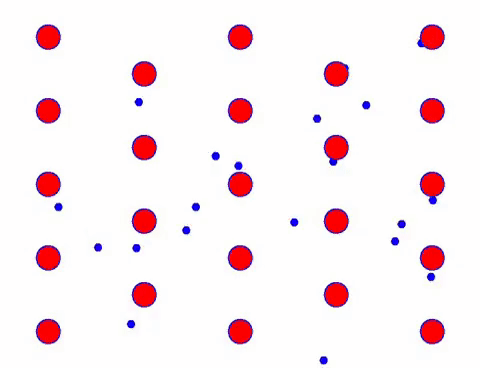
Indeed, the directional movement of electrons is much slower than the speed of thermal movement. This “grinding” movement of electrons is called drift, or “drift”. Sometimes, electrons will run in the opposite direction because of collisions with atoms. But in general, electrons move in one direction.
If the electric field changes direction, the direction of electron drift will also change.
Pertanto, questo tipo di movimento direzionale significa che la somma delle velocità di tutti gli elettroni che partecipano alla conduzione in un certo momento non è zero, ma è generalmente in una certa direzione. Questa direzione può essere cambiata in qualsiasi momento, ed è il caso della corrente alternata.
Therefore, current is not so much the “directional movement” of electric charge as it is the “collective movement” of electric charge.
L’intensità della corrente nel conduttore è espressa dall’intensità della corrente. L’intensità di corrente è definita come la quantità di elettricità che passa attraverso la sezione del conduttore nell’unità di tempo, vale a dire
Abbiamo appreso alcune grandezze fisiche che contengono la parola “intensità”, come l’intensità del campo elettrico e l’intensità dell’induzione magnetica. Rappresentano generalmente la ripartizione per unità di tempo, unità di superficie (o unità di volume, unità di angolo solido). Tuttavia, la parola “intensità” nell’intensità attuale non riflette l’attuale ripartizione dell’area.
In fact, another physical quantity is responsible for the distribution of current to area, which is current density.
Since the essence of electric current is the directional movement of electric charge, there must be a certain relationship between current intensity and drift speed!
Per ottenere questa relazione, dobbiamo prima chiarire una concentrazione di portatori di concetto, cioè il numero di portanti in un’unità di volume, che è espressa da .
It is assumed that the conductor cross section is, the carrier concentration is, the drift velocity is, and the charged charge is.
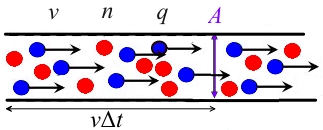
Quindi la carica nel conduttore sul lato sinistro della superficie è e queste cariche passeranno attraverso la superficie entro un certo periodo di tempo, quindi
Questa è un’espressione microscopica dell’intensità della corrente.
La densità di corrente è la ripartizione della corrente nell’area, quindi la grandezza della densità di corrente è, ma è definita come un vettore, e la direzione è la direzione del vettore della velocità di deriva dei portatori caricati positivamente, quindi la deriva degli elettroni nel metallo può essere ottenuto da questa velocità, come esempio di seguito.
Considera un filo di rame, assumendo che ogni atomo di rame contribuisca con un elettrone come portatore. C’è 1 mole di rame, il suo volume è, la massa molare è, la densità è, quindi la concentrazione di portatore del filo di rame è
Where is Avogadro’s constant. The density of copper is found, and the value obtained by substituting is about unit/cubic meter.
Supponendo che il raggio del filo di rame sia 0.8 mm, la corrente che scorre è 15 A, = 1.6 C e la velocità di deriva degli elettroni è calcolata come
Si può vedere che la velocità di deriva degli elettroni è davvero molto piccola.
For those who study circuits, the above is the complete definition of current.
But in physics, the above definition of current is actually only a narrow definition. More general currents are not limited to conductors, as long as the movement of electric charges is current. For example, when the electrons of a hydrogen atom move around the nucleus, an electric current is formed in its orbit.
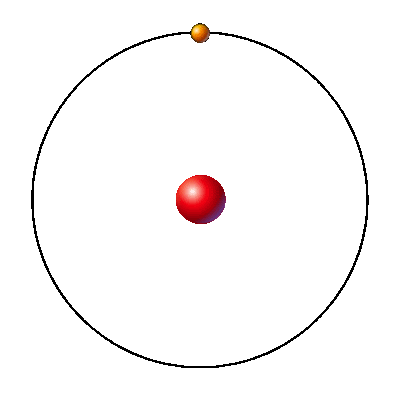
Suppose the amount of electronic charge is and the period of movement is. Then every time that elapses, there is such a large amount of charge passing through any cross section of the loop, so the current intensity is based on the relationship between period, frequency and angular velocity, and the current can also be expressed as
For another example, a charged metal disk, rotating around its axis, also forms loop currents with different radii.

Questo tipo di corrente non è una normale corrente di conduzione e non può generare calore Joule! Impossibile formare un vero e proprio circuito.
Otherwise, would you give me a calculation of how much joule heat is generated per second by the electrons of the hydrogen atom?
Infatti la corrente nel vuoto non soddisfa la legge di Ohm. Perché, per la corrente elettrica formata dal movimento di particelle cariche nel vuoto, i portatori non entrano in collisione in modo simile al reticolo nel metallo, quindi il vuoto non ha resistenza e conduttanza.
Il movimento delle cariche elettriche genera corrente elettrica e la carica elettrica stessa eccita il campo elettrico. Questo è facile da causare un malinteso. Molte persone pensano quindi che il campo elettrico delle particelle cariche che formano la corrente elettrica debba essere esposto. Ma in effetti, per la corrente di conduzione in un conduttore generale, i portatori scorrono su uno sfondo composto da un gran numero di ioni metallici carichi positivamente e il conduttore stesso è neutro!
Spesso chiamiamo questo tipo di corrente speciale “corrente equivalente”. L’equivalente qui significa che genera un campo magnetico sulla stessa base di una normale corrente di conduzione!
Promemoria: non confondere la “corrente equivalente” qui con il “circuito equivalente” nell’analisi del circuito
In fact, when we first studied the magnetic field, the electric current in Biot-Saffar’s law was the generalized electric current that contained this equivalent current. Of course, the conduction current in Maxwell’s equations also refers to the generalized current.
Those who have studied the photoelectric effect know that when the photoelectron drifts from the cathode to the anode, if the influence of air is ignored, this current is caused by the movement of electric charges in the vacuum, and there is no resistance, so it is not restricted by Ohm’s law.
So, is this the only thing about electric current in physics?
No! Esistono anche due tipi, vale a dire la corrente di magnetizzazione e la corrente di spostamento.
Sono anche due correnti equivalenti, che, come suggerisce il nome, vengono introdotte anche per spiegare il magnetismo. In altre parole, si sono staccati dalla caratteristica di base dell’attuale “movimento di carica”!
That’s amazing! There is no electric charge movement, so why can it be called an electric current?
Don’t worry, and listen to me slowly.
Diamo prima un’occhiata alla corrente di magnetizzazione.
È stato scoperto che il magnetismo è causato dal movimento dell’elettricità (non considerando la spiegazione del magnetismo dalle proprietà intrinseche dello spin per il momento). Per spiegare il magnetismo naturale, il fisico francese Ampere ha avanzato l’ipotesi della “circolazione molecolare”. 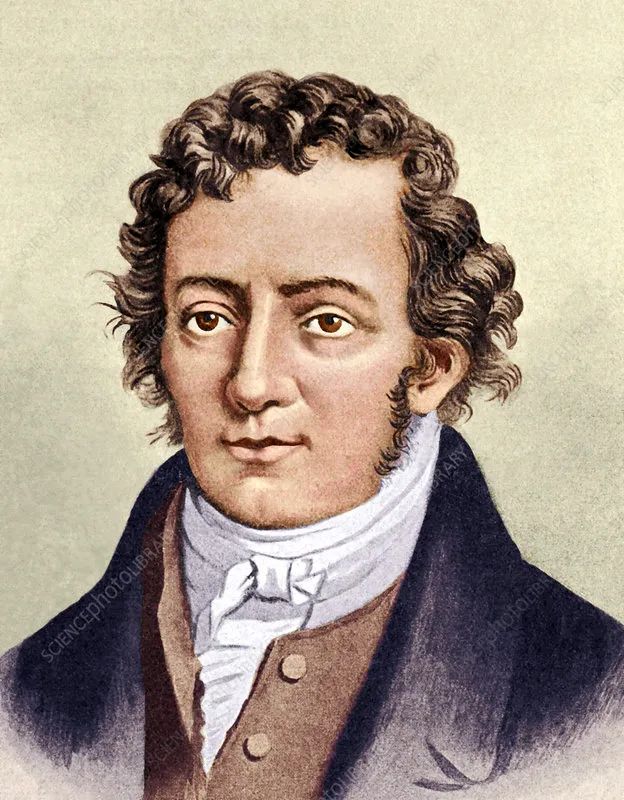
As shown in the figure below, any atom or molecule can be regarded as having an electric charge rotating around the center, forming a tiny loop current, that is, “molecular circulation”.
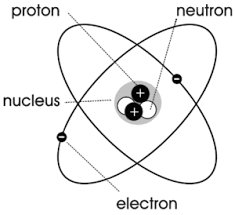
Secondo la legge che la corrente elettrica eccita il campo magnetico, questa circolazione molecolare produrrà una grandezza fisica chiamata momento magnetico. La sua dimensione è l’area racchiusa dalla circolazione molecolare moltiplicata per la corrente equivalente della circolazione molecolare, e la sua direzione è in relazione a spirale destrorsa con la direzione della circolazione, cioè
Obviously, the direction of the magnetic moment is exactly along the direction of the magnetic field formed by the circulating current
. 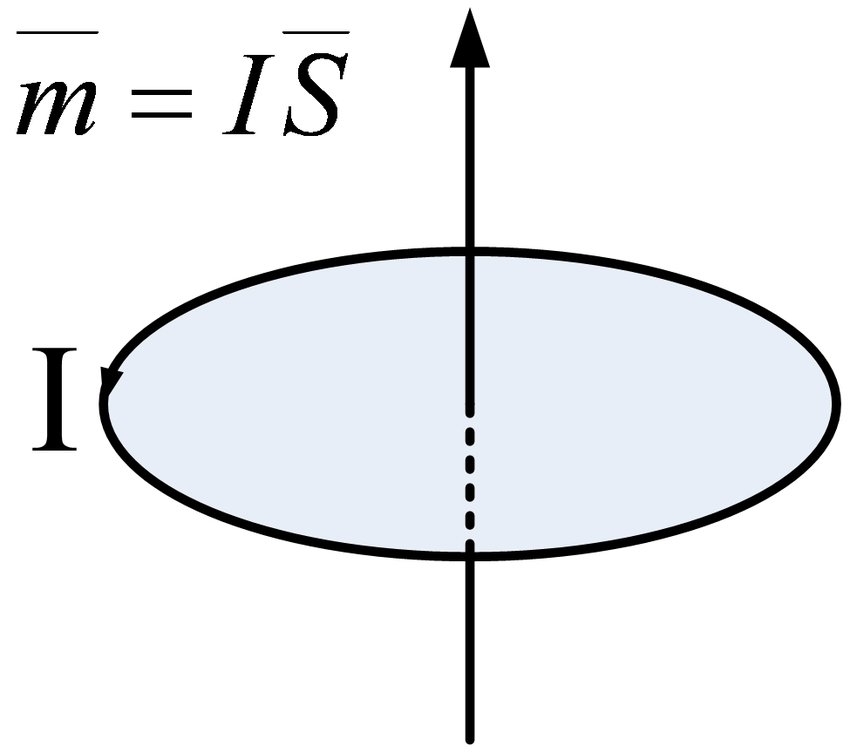
Under normal circumstances, the arrangement of the molecular circulation of a substance is chaotic, so the substance is not magnetic, as shown on the left side of the figure below. When subjected to an external magnetic field, these molecular circulations will be approximately neatly arranged. As shown on the right side of the figure below, their magnetic moments are arranged in one direction as much as possible, just like countless small magnetic needles gathered together to form a total magnetic field, and the whole material composed of them becomes magnetic.
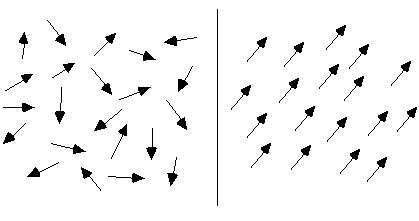
Suppose there is a cylindrical magnet, the inner molecular circulation is neatly arranged, and the sections of each molecular circulation at the edge of the magnet section are connected together to form a large circulation, as shown in the figure below. 
Sulla base di questo, possiamo pensare che un magnete a barra sia come un solenoide eccitato. In altre parole, c’è una corrente invisibile impigliata sulla superficie del magnete! Questo tipo di corrente non può essere collegato e utilizzato. È limitato alla superficie del magnete. La chiamiamo “corrente di legame” o “corrente di magnetizzazione”.
Pertanto, la corrente magnetizzante è una corrente, perché è la stessa della corrente formata dal movimento di cariche elettriche reali, che possono generare equivalentemente un campo magnetico!
Let’s look at the displacement current again.
According to the Ampere’s loop theorem, the integral of the magnetic field strength on a closed path is equal to the flux of the current density on any curved surface bounded by this path, that is, this theorem is called Stokes’ theorem in mathematics. It tells us that the integral of a vector along any closed path must be equal to the flux of its curl (here) to any surface bounded by the closed path.
Since it is a mathematical theorem, it must always be correct, because mathematics is a logical system based on axioms.
Therefore, the Ampere Loop Theorem must always hold!
However, the talented Scottish physicist Maxwell discovered that when faced with an unstable current circuit, the Ampere loop theorem was contradictory.
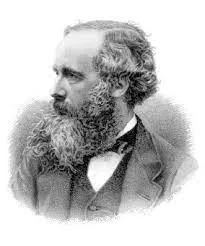
La tipica corrente instabile si verifica durante la carica e la scarica del condensatore. Come mostrato nella figura sottostante, c’è una corrente instabile durante il breve periodo di carica del condensatore.
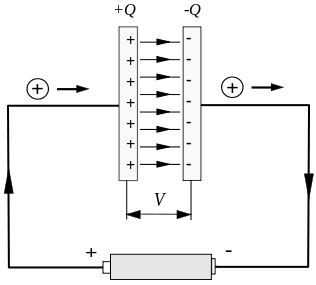
But the circuit is disconnected between the capacitor plates, which will cause a serious problem.
Supponiamo di considerare un percorso chiuso che aggira il filo, come mostrato nella figura sottostante, il cerchio contrassegnato da C e la superficie curva con esso come confine possono essere selezionati arbitrariamente. Nella figura, sono selezionati il piano circolare racchiuso da C stesso e attraverso il condensatore. La superficie curva della piastra sinistra. 
According to the circular surface, it can be seen that according to the curved surface, but as a loop integral of the magnetic field strength, its value should be determined!
Come fare?
Maxwell believes that the Ampere’s loop theorem must be established. Now that there is a problem, it must be because a part of the current has not been discovered by us before, but it does exist!
So, how to find out this part of the current?
Since the problem is between the plates, start from between the plates.
Through analysis, Maxwell found that regardless of charging or discharging, there is a physical quantity between the capacitor plates at all times that is synchronized with the magnitude and direction of the current. It is the time derivative of the flux of the electric displacement vector, that is, it is defined as the displacement current.
If it is considered that this part is the part of the current that has not been discovered before, then the complete current is now. That is to say, although the circuit between the plates is disconnected, the derivative of the electric displacement flux and the sum of the current together, as a whole , Ensure the continuity of the current at all times.
Going back to the previous contradiction, we now know that, according to the requirements of Stokes’ theorem, when calculating the flux of current density for a closed surface, the density of displacement current should also be considered, that is, the complete ampere loop theorem is therefore, By “discovering” this new current component, the crisis of the Ampere Loop Theorem is resolved!
Il motivo per cui qui non si usa “introduzione”, ma qui si usa “scoperta”. Quello che voglio sottolineare è che questo tipo di corrente non è una compensazione matematica, ma una cosa reale, ma non è stata scoperta prima.
Perché esiste in primo luogo? Poiché agisce come una corrente elettrica, come una corrente di conduzione, eccita un campo magnetico in modo equivalente, tranne per il fatto che non c’è movimento di cariche elettriche, non è richiesto alcun filo e non può essere generato calore Joule, quindi è stato ignorato!
But it actually exists by itself, just keep a low profile, it has been silently exciting the magnetic field there all the time!
In altre parole, quando ci troviamo di fronte a un campo magnetico, la definizione originale di corrente è troppo ristretta. L’essenza della corrente elettrica non è il movimento della carica elettrica, dovrebbe essere qualcosa che può eccitare un campo magnetico.
So far, the several forms of current have been introduced. They all exist objectively, and what they have in common is that all currents can equally excite the magnetic field.
